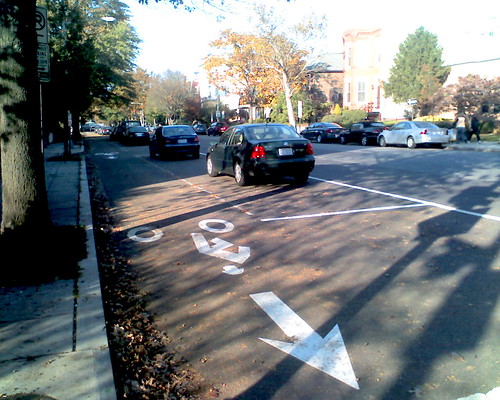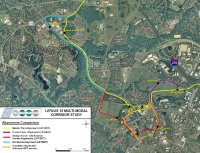|
Special Features





Image Libraries


|
|
Blog
This is the new contraflow “cycle track” on 15th Street:

Here are four more cycle track-like facilities around the country (click to enlarge each photo):
 |
 |
 |
 |
| Boulder |
Saint Petersburg |
New York Herald Square |
New York 9th Avenue |
Some of those are contraflow and some of them aren’t, but the key difference between what DDOT has installed on 15th Street and all these others is physical separation. Everywhere except DC there are curbs, or at least bollards, clearly delineating the bike space from cars. On 15th Street there’s a parking lane between speeding cars and bikes, but otherwise nothing but a painted stripe and some tiny reflectors. Portland has tried one without a curb, but even there the striping is much more substantial.
One the one hand, the lack of a curb, bollards, or even a bunch of green paint makes the bike track much less visible, and opens it up to invasion by cars more often. On the other hand, the lack of expensive components makes DC’s version much easier and less costly to put in place; no need to “construct” anything, just restripe and you’re done. Since money for bike/ped projects is often in short supply, this could mean the city might be able to implement more cycle tracks, more quickly.
What do folks think about this? Is it better to try the cheap fixes or is the more heavily engineered alternative necessary?
Update: ReadySetDC sends in an update. DDOT has added reflective posts.
Average Rating: 4.8 out of 5 based on 222 user reviews.
November 9th, 2009 | Permalink
Tags: galleries, transportation, urbandesign

|

The alignment alternatives MTA studied for the CCT. Click to enlarge. |
In 2006 I wrote about the terrible placement of stations along the adopted Corridor Cities Transitway alignment, and helped prepare an alternate route with the Action committee for Transit that would better serve Gaithersburg’s many but disjointed walkable areas. Following similar prodding by the City of Gaithersburg and Montgomery County, Maryland transit planners finally agreed to study modifications to the route.
Their report (pdf) came out yesterday.
Although planners didn’t study the more radical realignments BeyondDC and ACT like, they did look at three changes to more directly serve the “Science City“, Crown Farm, and Kentlands. Predicatbly, the report finds that thousands and thousands more riders would use the transitway if stops were positioned near walkable destinations rather than park and rides.

Depending on the mode, for an average of 15% more cost you get 39% more riders, just by switching a handful of stations to walkable locations. A locally preferred alternative has yet to be chosen, but presumably this makes the alignment decision pretty easy. MTA would be mad not to go with the alternate.
Average Rating: 4.8 out of 5 based on 158 user reviews.
November 6th, 2009 | Permalink
Tags: transportation

Much of Montgomery County is apparently stuck in gridlock today, as the county’s central traffic signal computer has failed. Traffic lights are cycling through red, yellow, and green, but there is no timing coordination; it’s every signal for itself.
In any complicated system this sort of thing inevitably happens once in a while. We all know the results of Metro’s automation failure last June, for example. One key difference, though, is network redundancy inherent to any multi-modal system. When the Red line went down, there were plenty of realistic alternatives. People switched to the 16th Street or Georgia Avenue buses, or drove, or cycled, or whatever. Losing the Red line for a while didn’t bring the region to a halt. On the other hand, if your system is built completely around one type of travel, when that system goes down you’re stuck up a creek without a paddle.
I don’t know how bad things are today in Montgomery County, but I’d venture they’re going better wherever there are options that allow people to bypass the gridlock via another mode.
Average Rating: 4.7 out of 5 based on 276 user reviews.
November 5th, 2009 | Permalink
Tags: transportation

|

Red is the Anacostia streetcar alignment. Blue is the segment that could be completed early. |
Last month we learned that DDOT was hoping to accelerate construction of the Anacostia and H Street streetcars. In a report from the Ward 8 streetcar meeting on November 2, Ezra Klein’s Coolest Couple reports that the segment of the Anacostia streetcar from Bolling Air Force Base to the Anacostia Metro station may be ready to open by 2011 instead of 2012, as had been previously anticipated. They also report that the H Street streetcar may be ready by then as well.
That would certainly be good news. If that’s the timeline, however, DDOT will have to solve the overhead wire issue and start procuring additional tram vehicles very soon.
Average Rating: 4.6 out of 5 based on 275 user reviews.
November 4th, 2009 | Permalink
Tags: transportation

You’ve got to start getting in early. Throwing a fit after all the decisions have already been made just isn’t good government.
|
|
Dear Jim Graham,
If you are going to take an active interest in transportation projects in the District that is wonderful. Your comments, and comments from your constituents, can be very helpful. Really.
But for the love of God, please stop butting in at the 11th hour.
Everyone appreciates your involvement in the streetcar planning now, but your insistence on becoming involved only after years of planning had already happened delayed construction. You had three years to voice your concerns about the Anacostia streetcar, and didn’t do so until it was well past the appropriate time.
Now you’re pulling the same act again, with the 15th street bike lane. DDOT proposed the project a year ago and sent residents a letter informing them of the impending construction last month. The proposal has been widely known-about and anticipated by the transportation activist community. Yet today you’re claiming the project is a surprise.
Here’s the deal, Jim. If you expect to be taken seriously as a voice of authority in these matters, you’ve got to do a better job of knowing about them. You can help, but you’ve got to start getting in early. Throwing a fit after all the decisions have already been made and after anyone paying attention has already had plenty of opportunity to be involved just isn’t good government.
Average Rating: 4.9 out of 5 based on 207 user reviews.
November 4th, 2009 | Permalink
Tags: government, people, transportation


|
Media





Site
About BeyondDC
Archive 2003-06
Contact
Category Tags:
Partners
|





















